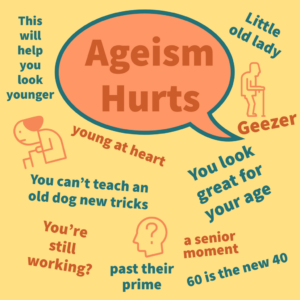Healthy Aging Part 5: Defeating Ageism
by Robin Bush, ISR Communications
Ageism was coined in 1968, and defined as prejudicial attitudes and policies that perpetuate negative stereotypes toward older people. Over 50 years later, the negative portrayal of age is still embedded in every aspect of our culture. Ageism causes people to be excluded from society, limits people’s activities and aspirations, and damages health and well-being. The W.H.O. defines ageism as “the stereotypes (how we think), prejudice (how we feel), and discrimination (how we act) toward people based on their age.” While our population is aging and people are living longer, the myths that cognitive and physical decline is inevitable and that older people are a drain on society perpetuate discrimination against older Americans. But this can change. One out of five Americans is projected to be over 60 in 2025. This age group is a powerful force for social change. The baby boomers are more educated than previous generations and, as a group, have a history of being social activists. Now more than ever, it is time to understand the proliferation of ageism in our culture and to do something about it.
Ageism in language. Have you experienced someone making an ageist comment to you, or do you find yourself saying some of these phrases?
You still have time
You look great for your age
Person of a certain age
Are you still working?
Past your prime
You can’t teach an old dog new tricks
You are young at heart
A senior moment
Name-calling like: geezer, little old lady, little old man
You look great for your age
60 is the new 40
Past her prime
What does she expect at her age
That’s ageist language, and it is hurtful.
Ageism in the job market. According to the Center for Aging Better, more than a third of 50–70-year-olds feel they are disadvantaged when applying for jobs, “Older adults are brought in for interview at a rate similar to younger applicants, yet older workers are offered jobs 40% less frequently than younger candidates with similar skills (Zippia). Older workers are often misperceived as being resistant to change, slower at adopting technology, having less energy, and thus frequently receive less training or promotions. While some businesses work hard to be known for their 50+ workforce, they often offer jobs that do not use the experience and skills of older workers.
Ageism in healthcare. Ageism can lead to older people not receiving the physical and mental healthcare they need. Assumptions are made about inevitable physical and cognitive decline, which reduces research, attention to symptoms, lack of testing of medications on those 75+, and few providers willing and qualified to take older patients. Only a small percentage of American medical schools require coursework in geriatric medicine, and there are about 7,000 geriatricians for a 54+ million American senior population. It is predicted we will need over 77,000 geriatricians by 2025. Research also shows that attitudes toward aging can contribute to healthcare staff spending less time with older patients resulting in less attention and less treatment which compromises physical and mental health and results in higher rates of illness, increased care needs, and reduced quality of life.
Ageism in Media. Mass media perpetuates ageism. A quarter of ads feature people in their 50’s, and only 5% feature those over 70. Americans spend billions of dollars on anti-aging products each year, from hormones, sexual dysfunction medication, steroids, supplements, over-the-counter medications, plastic surgery, diet drinks, and books on how to keep from growing old. The message is “Don’t grow old.” In 2021, only 2% of top movies had senior lead actors with less than 10% on TV.
Steps of action. Ageism surrounds us, but recognition empowers us to take action against it. The W.H.O. says there are three ways to do this:
- Education to dispel myths and stereotypes and then to raise awareness of the impact of ageism on individuals and our culture.
- Create intergenerational opportunities to build cooperation and empathy across generations.
- Work toward law and policy changes to reduce inequity and discrimination.
Not all of us can be involved in system-wide and culturally reforming action. Still, we can contribute to these efforts by understanding how ageism impacts our thinking and life experiences.
What CAN we do?
- Seek opportunities for continuing education to develop new skills that keep pace with the job market
- Advocate for built environment considerations (ramps, handrails, elevators)
- Participate in intergenerational activities. Children who lack contact with older persons can develop ageist attitudes
- Use purchasing power to support companies who use older spokespersons
- Contribute value through voluntary activities
- Advocate for pension plans and other retiree benefits
- Encourage elected officials to create legislation that provides legal protection against age discrimination
- Read “This Chair Rocks: A Manifesto Against Ageism” by Ashton Applewhite and “Breaking the Age Code” by Becca Levy, Ph.D.
We can reduce ageism by sharing our strength, vitality, and wisdom with others and by becoming powerful examples of the benefits to society of our longevity. It is time to move forward together!

